
Provisioning Locations at Sea During the Golden Age of Piracy
"Without question, equipping and preserving sufficient food and drink on long-distance voyages was intimately tied with the survival of the crew in terms of morale and nutrition and, ultimately, could determine the success or failure of the voyage." (Cheryl A. Fury, "Health and Health Care at Sea", The Social History of English Seamen, 1485-1649, p. 198)
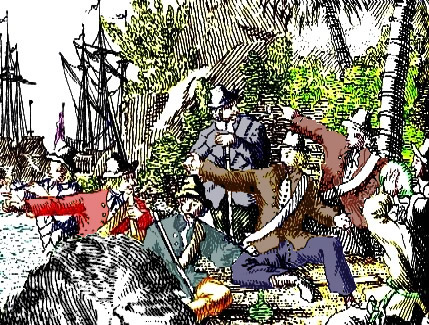
Pirate Edward Low's Men Dining, From
Historie der Engelsche Zee-Rovers (1725)
Food is a topic of monumental importance to all those who made voyages of any significant duration. It had a direct impact on the health and well-being of a crew and was considered a crucial part of those healing from wounds and surgeries during the golden age of piracy.
This is the third of a series of articles which looks at the formal and informal provisioning locations used by English sailors during the golden age of piracy (1690-1725), broadly dividing them into navy sailors, merchants, privateers, select buccaneers, and pirates. It focuses on locations where sailors could regularly obtain food while they were traveling by sea. The first article examines how food was used by the body and looked at the perception of healthiness of food provided to sailors. The second article discusses the many ways sailors obtained food while traveling. The fourth article looks at victualling and the food consumed by the navy, navy officers, merchants, privateers and pirates. The people and procedures common to all sailors during this period are discussed in the fifth article including an examination of how food was handled, cooked and eaten shipboard.
Provisioning Location Overview
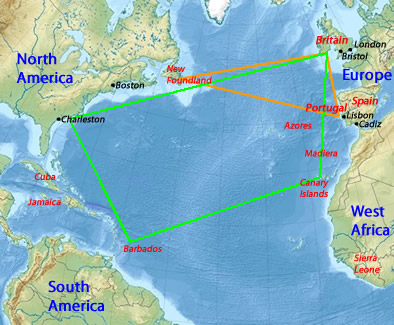
The North Atlantic 'Triangle' Trade Route (In Green)
During the golden age of piracy (1690-1725) there were two 'waves' of pirates - those who prowled the East Indies in the early half of the period and those attacked commerce in the West Indies during the latter half of the period. The pirates chose these locations because their prey was there. In the East Indies large East India merchant vessels, moneyed pilgrims carrying their wealth to Mecca and local 'country ships' sailed the Indian Ocean. In the West Indies there were the (relatively) smaller merchant ships engaged transporting goods along the so-called 'triangle trade' which included Europe, Africa and the West
Indies and American colonies. In addition, a few buccaneers and privateers were still active around this time, their routes typically carrying them from Europe to the West Indies, around South America, across the Pacific to the East Indies, around Africa and back home. Each of these sailors had to find places to re-provision their vessels in locations that were not entirely friendly to them. Pirates were particularly tasked with finding locations to get food because they were criminals and subject to hanging if caught. So they had to be cautious when using civilized ports to obtain provisions for their ships.
It is possible, even likely, that some pirates made their way ashore in disguise to towns where they purchased food. Unfortunately, examples of such incidents are not likely to be found because most of the pirate records come from newspaper accounts, court records and local officials' reports concerning pirate attacks, captures and sentencing. So evidence of pirates arriving into established ports and procuring food undetected wouldn't be found in these records unless it was among the few accounts the pirates themselves gave.
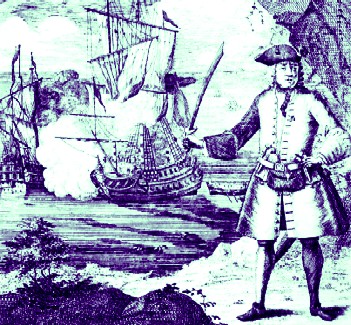
Pirate Henry Every and His Ship Fancy (18th Century)
One example of this comes from the testimony of William Phillips, who sailed with Henry Every. Shortly after Every led the crew to mutiny in August of 1693, Phillips explains that the mutineers, "finding ourselves short of provisions... went to the Island of May [Maio, one of the Cape Verde Islands] being a Portugueze Island near the coast of Guinea where we took in salt and about Twenty Bullocks. Here we met with three English ships which we did no injury to but paid them for what we
had of them"1. During their voyage, Phillips explains that Every also stopped to purchase food at the islands of Annobόn2, Madagascar3, Anjouan4, (Ndzwani) and the Mascerenes5, all during which they were neither recognized nor colluded with those from whom they bought food. Without Phillips' testimony, such provisioning stops would almost certainly have remained unknown to the public. (Fellow deponents John Sparks and David Evans recall many of these same stops in their testimony6, yet they don't mention procuring food there, instead recalling crimes committed nearby as expected during a criminal testimony.) Most of these stops appear to have been early in Every's pirate career, which may have helped him to avoid notice.
Contrast this with what happened to one of Low's pirate sloops, which had left Low to search for a pair of ships sailing to the Cape Verde Islands so they could plunder them of their provisions. Failing to find the ships, the crew was "reduced to great Necessities for want of Provisions and Water... they ventured to go ashore at St. Michael's [São Miguel, Azores Islands] for a Supply, and pass for a Trader, but they play'd their Parts so aukwardly, that they were suspected by the Governor to be what they really were"7. Portuguese sailors recognized a few members of the crew and, as a result, "the whole Crew was conduc[t]ed into the Castle [prison], where they were provided for as long as they liv'd."8 (For a variety of other examples of pirates having trouble stopping at established ports, see the examples given in the article Fresh Water and Pirates.)
The final category of English sailors of interest was the British navy who were somewhat active
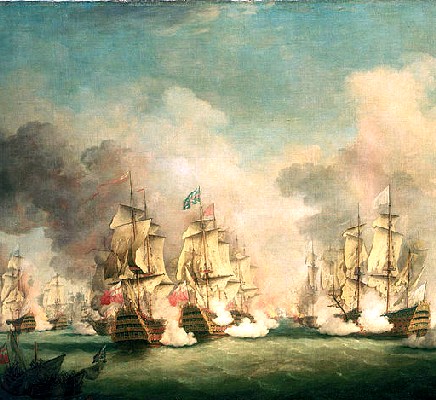
Artist: Richard Paton - The Battle of Barfleur, War of the League of Augsberg (18th century)
in the East and West Indies, although much of their focus at this time was on Europe and the Mediterranean Sea. In the centuries leading up to this period, the English navy had developed a system for supplying themselves with provisions. This was no mean feat; as historian John Ehrman explained in his book on the War of the League of Augsberg (also called the Nine Years War, 1689-1697), the navy "had to feed a population larger than that of any town in England, except London, and almost half that of the capital itself within its walls,
at a higher and more uniform rate than that enjoyed by any urban population."9
Having these different types of sailors in mind, here are a series of articles which examine some of the provisioning locations which were available to the different groups of sailors. The first article looks at the English Royal Navy victualling stations in use shortly before, during and shortly after this period which are naturally different in nature than those used by any of the other groups under study here. It is followed by articles about locations mentioned in accounts from around the golden age of piracy in three areas which were frequented by pirates - the Western Hemisphere, the Eastern Coast of Africa and the Western Coast of Africa.
Each article is found by either clicking on the appropriate location text in the image below or using the links in the description under the image.
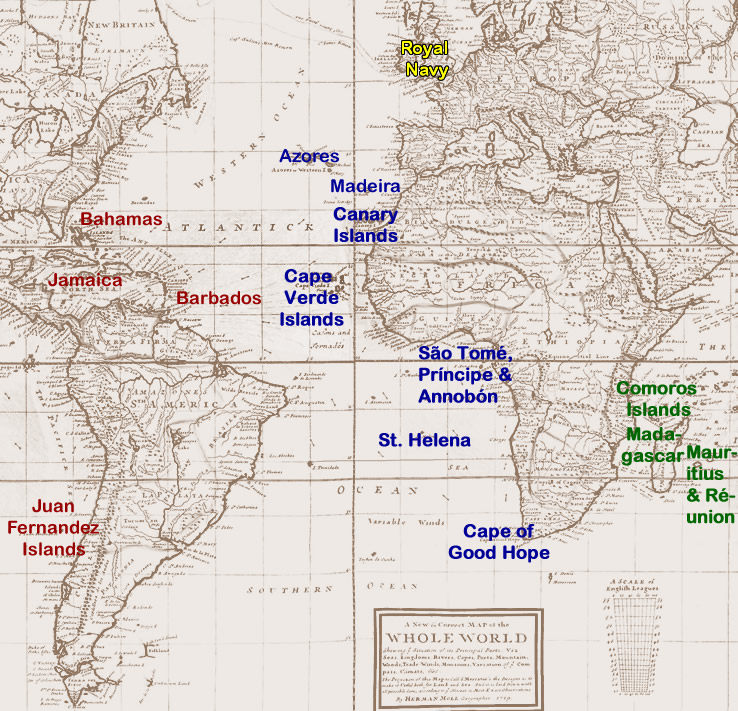 Cartographer: Herman Moll - A New and Correct Map of the Whole World (1719)
Cartographer: Herman Moll - A New and Correct Map of the Whole World (1719)Text Links for Map Selections: Royal Navy: Provisioning Yards; Western Hemisphere: Bahamas, Jamaica, Barbados & Juan Fernandez Islands; Eastern Coast of Africa: Azores, Madiera, Canary Islands, Cape Verde Islands, Sao Tomé, Príncipe, and Annobón, St. Helena and The Cape of Good Hope Western Coast of Africa: Mauritius and Réunion, Madagascar, Comoros Islands |
1 "2. William Phillips: The Voluntary Confession and Discovery of William Phillips, 8 August, 1696. SP 63/358, ff. 127-132", Pirates in Their Own Words, Ed Fox, ed., 2014, p. 23; 2 "2. William Phillips...", p. 24; 3,4 "2. William Phillips...", p. 25; 5 "2. William Phillips...", p. 28; 6 See Pirates in Their Own Words, pp. 34-9; 7,8 Captain Charles Johnson, A general history of the pirates, 2nd Edition, 1724, p. 376; 9 John Ehrman, The Navy in the War of William III 1689-1697, 1953, p. 144

